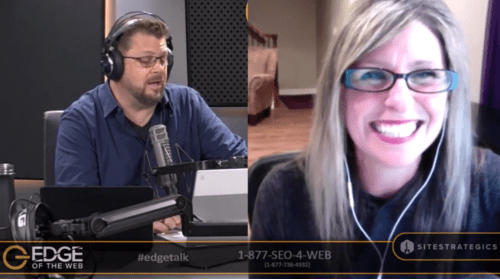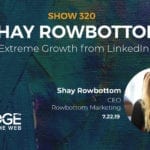Our special guest for episode 318 of the award-winning EDGE of the Web podcast was Traci Reuter, Founder and CEO of Divine Social. Site Strategics CEO Erin Sparks spoke with Traci about strategies focused on the customer journey, and how you architect a process to take people from complete stranger to having them fall in love with you. Here’s what we learned:
Traci Reuter: Her Background and Experience
Traci Reuter is the founder and CEO of Divine Social, and she believes entrepreneurs and businesses can change the world. Her mission is to support them along the way. She’s passionate about helping business owners build and grow their brands so they can better focus on providing value to their customers and positively impacting the world. Traci is certified in all things related to Instagram and Facebook, and she’s also currently managing about $4 million dollars in annual advertising spends each year for her clients. She was also a contributing author to the bestselling book, The Ultimate Guide to Facebook Advertising.
Traci grew up in a blue collar family of mostly factory workers, but she had an uncle who was an entrepreneur. She was fascinated by watching him build something out of nothing. Little did she know how powerful a subconscious impact it had on her. She was running a sales division of AT&T a couple of decades ago when her husband fell very ill. She had to back off her 80-hour work weeks at AT&T, but what could she do instead? Drawing on her marketing and sales degree, she decided to jump into the early days of digital advertising. Making the transition from offline to online was hard, especially in terms of trying to show any kind of return on investment (ROI) as compared to offline advertising. As a business person, this drove her crazy, but she figured it out. And she found herself thinking about her uncle, who started out with a pizza shop. Then he was able to buy the mall where the pizza shop was located. Then he bought a piece of property. He became a multi-million dollar real estate investor through entrepreneurial grit and determination. It inspired her to start her own business in spite of how risky it felt. But above all she wanted to use her marketing superpowers for good, to have a positive impact on businesses and communities. The result was Divine Social, a company focused solely on paid social media advertising on Instagram and Facebook. But entrepreneurialism is hard, and it’s certainly not for the faint of heart.
To Have a Big Impact, You Have to Focus
One of the things Traci learned was how her team knew quite a bit about a lot, but if you want to achieve excellence, you have developed the depth of knowledge in a limited area, which is why Divine Social focuses on paid social media ads in Facebook and Instagram. You have to learn how to say no to a lot of client requests in order to maintain a focus and achieve excellence. When Divine Social did that, their value went up, as did the results they achieved for clients. Trying to be a jack-of-all-trades in digital marketing is simply a losing proposition. It’s hard enough to stay on top of changes in your local area. Staying on top of everything else is just impossible. The result is that there are way too many marketers and agencies trying to do things they’re not good at, and the results are crappy results for clients. This is what happens when web design agencies or SEO agencies try to run social advertising campaigns, but it won’t be as good as campaigns run by agencies who focus only on social advertising. It’s just the reality of things.
How to Define Your Ideal Customer for Campaigns
A lot of companies (even well-established ones) will say they know their ideal customer, but when you start to dig deeper, you realize they really don’t know. Step one is nailing down the basic demographic characteristics: Men? Women? Children? Elderly? Step two gets into psychographics. What are their likes? What do they dislike? What podcasts are they listening to? What TV shows are they watching? Once you get a better handle on this, then you’ve got the beginnings of a foundation to build upon. And you can’t take multiple ideal clients and then lump them all together with one campaign because it will inevitably miss the mark. It won’t work for multiple ideal clients. Each distinct ideal client needs its own campaign. At Divine Social, when taking on a new client, there is a dedicated person who will spend a good 15 hours or more just nailing down the psychographics of the company’s ideal prospects. And the company will inevitably be surprised at all the different pieces they hadn’t thought of before.
Another thing that happens is that a company goes too broad in defining their ideal client. For example, a company might say the ideal customer is a woman aged 25-65. That’s too broad. When Divine Social did their research, they discovered two distinct ideal customers, one aged 25-40 and the other aged 40-65 that had totally different needs and desires. The company was sending the same message to both types of ideal client and it wasn’t working (go figure). It’s okay to have multiple segments if the data shows how to clearly define them. For many businesses, this is the key to scaling up. But testing is key. Marketing has been based on testing your ideas because things change and you can never just assume something will work without first testing it.
Three Types of Entrepreneurs and Why It’s Good to Know About Them
When a marketing agency takes on a new high-powered, successful company, the marketers tend to assume the company’s marketing must be totally dialed in, but it’s surprising how often this is not the case. As one such client explained to Traci, there are three kinds of entrepreneurs: There’s the product entrepreneur who creates the perfect product (Steve Jobs at Apple), then there’s the customer experience entrepreneur who focuses mostly on creating stellar customer experiences (Jeff Bezos at Amazon), and then there’s the marketing entrepreneur (such as Gary Vee) who just think marketing all day long. As an agency, you need to which kind of entrepreneur you’re dealing with, because if it’s a product or customer experience entrepreneur, their brains work differently from those of marketers. You have to take a different approach with the ones that don’t already think like marketers.
Matching Marketing to Ideal Clients
Once you have your ideal customer segments nailed down, you can start developing the right marketing messages for each one. Traci has identified what she calls the Three Pillars to Successful Social Ads. 1) Building out your audience demographically and psychographically as previously mentioned, 2) Engagement is the one so many miss out on, and 3) Conversions, which is what too many focus on obsessively and why consumers are tuning out. Conversion ads are one kind of ad, but they’ll miss the mark if you haven’t first built out your audience and engaged them. The engagement-style ad is critical because that’s where a company builds the “know, like, trust” factor for their brand, but many companies skip over it entirely, to their peril. Because it’s a marketing truth that all things being equal, people do business with people they know, like, and trust (as explained by author and business guru Bob Burg.
The power of digital advertising is that you can be in front of consumers a lot, which is even more important with a longer sales cycle, in order to build up that know-like-trust factor. Research shows only 2% of consumers make a purchase after seeing just one offer. What do you do with the other 98%? This is where the engagement piece is critical. If all you do is direct response advertising, you might as well just pile up your money and set it on fire.
You engage them by building campaigns fashioned around something like Eugene Schwartz’s Five Levels of Awareness. Very useful for marketers (or anyone) to understand how someone goes from being completely unaware they have a problem all the way to knowing they have a problem and that your company has a solution and they’re just waiting for the right timing. An engagement campaign doesn’t ask people to buy anything. The just deliver value so that you can later re-market them and gently guide them along the buying journey. When it’s time for the final push to purchase, then (and only then) should you be talking about a conversion ad campaign. Your engagement content has to be crafted in a way that naturally leads to the offer.
Special Landing Page for EDGE Fans on Divine Social
If you enjoyed Episode 318 of the EDGE with special guest Traci Reuter, she has created a special landing page where you can take a deeper dive with Divine Social. Just visit https://divinesocial.com/edge and see what’s there for you!
Connect with Traci Reuter and Divine Social
Twitter: @tracireuter (https://twitter.com/tracireuter)
Facebook: @TraciReuterSocial (https://www.facebook.com/TraciReuterSocial/)
Instagram: @tracireuter (https://www.instagram.com/tracireuter/)
LinkedIn: https://www.linkedin.com/in/tracireuter/
Divine Social website: http://divinesocial.com
Is Your Digital Marketing ROI Everything it Could Be?
Time to get a grip on your digital marketing ROI? Get it done with a Site Strategics report examining your SEO, content, social media, and PPC. Visit https://edgeofthewebradio.com/roi/ to get 30% off a comprehensive review of your digital assets!


